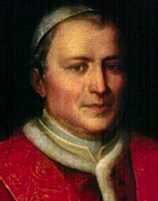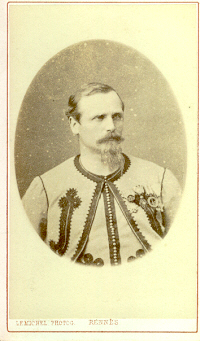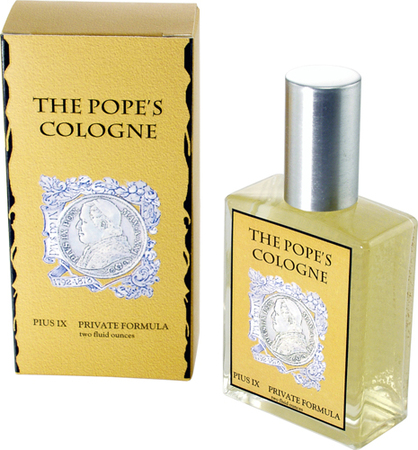The Pope's Cologne by Excelsis Fine Fragrances: An Homage to Pie IX (Mid to Late 1800's - 2006) {Perfume Review & Musings} {Men's Cologne} {Celebrity Fragrance}
Through some mysterious accidents of history, the recipe for a cologne that was once upon a time used by Pope Pie IX (1792-1878) - the longest reigning pope in the history of the Catholic church after Saint Peter (1846-1878) - ended up twelve years ago in the hands of a general physician from San Francisco, Dr. Fred Hass, who decided, almost on a whim, to resurrect the 19th century formula.
All that is known with some certainty is that the recipe left the Vatican premises in the luggage of the commander of the Pontifical Zouaves (the Pope's guard) Colonel Baron Anasthase De Charette, a French Catholic nobleman who had come to the rescue of the papacy in the troubled years of its struggles with Garibaldi.
How did this personal grooming item came to be passed on from the head of the Catholic church to the head of his guard, who it seems always the Frenchman, recognized the qualities of the perfume well enough to wish to reproduce it, is another pretext for imaginative speculation provoked by what Rousseau called the sense of the imagination, i.e;, olfaction. The puzzle could probably best be clarified by descendants of the De Charette family, if anyone remembers anything about it still.
The 19th century was an era in which fragrance recipes were liberally circulated in advice books and reproduced at home....


The recipe, at any rate, ended up in the printed form in an edition of an American cookbook from Maryland published in 1963 in the tradition of these books containing all sorts of recipes versatile enough to be used on the skin, the hair, the teeth, the bed-sheets, and what not, side by side with actual cooking recipes. Fred Hass told The Scented Salamander by writing that,
"About 12 years ago my sister sent me an old cook book that had been published over and over by a Women's League in Maryland. In the back of this book were formulae for making stain remover, silver polish, for getting fleas off your dog, and a section on fragrances: sachets, pomanders and, it jumped off the page at me, "The Pope's Cologne". So I decided I would make some and it was very nice. I said to myself, "Someday I'll make it and sell it." So a couple years ago I started reading about perfumery, became fascinated with it and started making The Pope's Cologne. I had no background in perfumery but have practiced in general practice as a physician for almost forty years.
I have become so interested that I have acquired many various essential oils and have created other fragrances which I am planning on producing and trying to market."
A wedding notice in the New York Times from 1909 reveals that there was an American connection for the De Charette family as Baron Anasthase de Charette's wife is presented in the column as the former "Annette Polk of Tennessee." Their son, the Marquis de Charette, was to marry in Saint Patrick's Cathedral his bride of American stock, Susanne Henning. (Anasthase de Charette's own mother was half-English, being the daughter of the Duc de Berry and Amy Brown.) There is therefore a possibility that the recipe found its way to America and then to an American cookbook through family connections since a U.S.- De Charette linkage seems confirmed. Pie IX moreover would have been a popular pope for Americans as he is known for his work in developing dioceses in the United States.
Although the future Pope Pie IX born Giovanni Maria in Senigallia to Count Mastai Ferreti and Caterina Solazzi from a local noble family would be elected for his liberal views, he is famously known for having let his deeply conservative tendencies take over later on in his life due to the political turmoil in which Italy was then thrown over its unification attempts. He thus became known as the inventor of the doctrines of the Immaculate Conception and Papal Infallibility in the later period of his existence.
The Pope's Cologne, we wager, will probably mostly reveal his aesthetic taste. Judging from the cologne itself it shows a man of refined taste who obviously valued subtlety, elegance and even, the rare. The scent has a quaint charm about it, especially when the floral notes start being felt, which is quite remarkable. It is a perfume recipe made in a time when flowers in masculine colognes were felt to be perfectly natural additions hence an absolute lack of showiness and complete sense of maturity and naturalness about the floral notes in this composition. Being a cologne meant to be worn by the Pope, it had to be restrained in principle and it is in fact; there is no unexpected flamboyance or hidden coquetry peeking through. Naturally, the animalic notes are extremely discreet. Perhaps we can also imagine that a certain ethereal quality, a lightness and freshness were cultivated as befitting the pope's image. The citruses and lemon verbena are invigorating, a definite plus for a man in a public function. The fragrance is that of a man of patrician or aristocratic tastes.
The combination of citruses, lemon verbena and violet is enchanting, almost childlike in its softness and innocence. One feels inspired to make a drink that would be scented with these two main notes, violet and lemon. A "visual impression" blending the colors yellow and mauve is also appealing to the mind.
Smelt from the flacon, the first aromas that strike the nose are citruses, woods and amber. The start of the perfume is very citrus-y, a bit candied evoking lemon drops like an outburst of freshly squeezed lemon juice with undertones of marine ambergris. The cologne then warms up becoming more powdery and vanillic, in a very understated way. Then there is a more vegetal, aromatic impression suggestive of the underbrush, which kicks in.
One smells a stylized subtle violet with some clove in it, perhaps some carnation since the powdery feel becomes a little bit more accentuated gliding even into a creamy impression. The blend at this point feels very elegant and refined, aristocratic even, showcasing an accord that feels rarefied and unusual. Very delicate floral nuances arise betraying tinges of rose, peach and then mauve. It smells a little bit of orange-blossom-scented mauve guimauve, albeit in a non-foody manner. The woods then become more apparent, and the most finely textured one amongst them, sandalwood in particular, it seems. There is also a little bit of a birch tar impression, yet very discreet as the dry-down evokes a more familiar impression found in Russian leather scents. The longer dry-down smells a bit of the woodiness of orris. All the while, the citruses impart their freshness to this elegantissime scent.
The recipe of the 19th century cologne was faithfully followed by Dr. Fred Hass (he incidentally happens to be US Poet-Laureate Robert Hass' brother) therefore the longevity authentically mimics that of a perfume from that period. Fred Hass told us that he made the choice of not touching the original recipe. The perfume leaves a very subtle scent on the skin, which contributes to the overall feeling of genuine old-world elegance.
The recipe remains undisclosed; main ingredients cited are: orange blossom, lemon verbena, lavender, violet, clove and sweet orange.
A flacon retails for $25.95 only. If you buy one to eleven dozens, it is available for $156 per dozen, etc. The packaging is gift-worthy so it could potentially be a lovely present for Christmas. Please note that shipping is free during the Holidays' season.
You can purchase the scent directly from the website The Pope's Cologne











Although I like the idea of a Pope Pie (born Venti Cappuccino, a lovely combination), I do find it odd that a Pope who took the name Pius wore fragrance. Although I'm not Catholic, I have the idea he preceded Leo XIII, the working class Pope. All this may explain a lot.
This is an interesting thought. I personally have no problem imagining a Pope wearing a cologne. Their surroundings are sumptuous, their clothes and jewelry too. It would be more surprising to discover that said cologne was heavily animalic, but that also would surprise me only mildly.
This cologne is very elegant and polite (but not bland) so I don't think that it would be feel out of place at the Vatican
Are you surprised because perfume signals coquetry and seduction? It could be worn and even "drunk" actually for therapeutic reasons in that era or to simply cover bad smells.
Does anyone own this? Can anyone tell me if its good?
This cologne is wonderful. I have already bought 6 bottles. I have given as gifts to family members. We are catholic, and believe it also has healing powers. Smells wonderful. Unisex applicable.